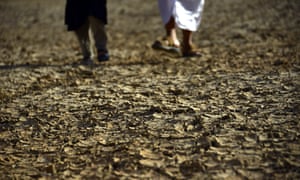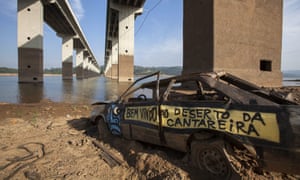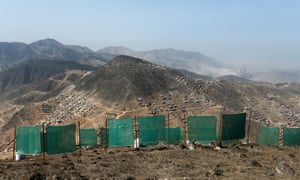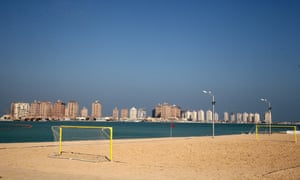In the southern reaches of Egypt, the city of Aswan is one of the hottest and sunniest in the world. Temperatures reach 41C in the summer and less than a millimetre of rain falls each year. Some years it doesn’t rain at all.
Aswan may be one of the world’s least rainy places, but it’s not even close to being the most water-stressed city. It nestles on the east bank of the Nile, close to the Aswan High Dam and the vast Lake Nasser, one of the largest manmade lakes in the world. With a capacity of 132 cubic km, the dam serves the irrigations needs not just of Aswan, but Egypt and neighbouring Sudan as well.
Water stress – where the human or ecological demand for water is not met – is caused by a variety of factors. There’s the physical scarcity of water due to lack of rainfall, the natural aridity of the area and, increasingly, changes in climate; but poor management and investment in water infrastructure, and pollution, also play their parts.
The problem affects an estimated 2.7 billion people for at least one month of every year, across every continent – and is particularly pressing in cities as the global urban population grows. At present, almost four billion people live in cities, with a further 2.5 billion expected to join them by 2050.
As the urban population grows, so too does the number of people living in settlements that are not connected to a formal piped water supply. Currently, some 860 million people live in slums around the world; their lack of access to clean water carries enormous health consequences.

As freshwater supplies dry up, many cities are engaged in a race to the bottom as they turn to groundwater – with some underground aquifers now so overexploited that water is extracted much faster than it is recharged. During the height of the recent drought in California, farms and cities were apparently drilling so deeply for groundwater that they tapped into reserves that had fallen to earth as rain 20,000 years ago.
Over the past few years, both Los Angeles and São Paulo have been hit by major droughts affecting their surrounding states. For California, 2014 and 2015 were the two hottest years in its history; in April last year, the state’s Department of Water Resources found “no snow whatsoever” during its survey in the Sierra Nevada mountains.
Droughts creep up and develop over a period of time. But very often they end suddenly, with a crash of flooding
“We get all of our water for the year through the winter months, and we hope that accumulates in reservoirs and as snowpack to draw on as a resource over the summer,” says Paul Ullrich, assistant professor of regional and global climate modelling at UC Davis. “In the absence of snow pack or precipitation in winter, we turn to pumping groundwater – but it’s our insurance policy, our emergency fund.”
In response to the absence of snow, the governor of California, Jerry Brown, announced mandatory regulations that prohibited the watering of ornamental grass, required new homes to use drip irrigation, and directed water agencies to set up new pricing structures to maximise conservation.
In Brazil meanwhile, the main reservoir supplying São Paulo dropped to just 6% of its capacity and residents were hit with regular water rationing. Some were forced to move away to more water-reliable areas.

Droughts can last for decades, but they are temporary. “Droughts creep up and develop over a period of time, through an uncertain space – and get worse,” says Carolyn Roberts of the Knowledge Transfer Network. “But very often they end suddenly, with a crash, bang and wallop of flooding.”
While the droughts affecting Los Angeles and Sao Paulo – both of which are now said to be over – had a severe impact on these cities, neither can be placed among the world’s most water-stressed. In Los Angeles, “after per capita use, there is twice as much water as there is in the UK even now,” says Roberts.
And São Paulo? “It’s not in a structurally water-scarce environment. But as the city has grown, the ability of the water management infrastructure to withstand a multi-year drought was clearly overwhelmed,” says Steven Schonberger, water global practice manager at the World Bank. “It may have been one of the top water-scarce cities last year – but two or three years from now, with some significant rain, that could all turn around.”
There are many cities, like Aswan, that never receive any significant rainfall. Lima is a particular concern, built on the Peruvian coast: one of the driest desert regions in the world. The city, with a population of around 8.5 million, depends mainly on the Rímac river, plus the Chillón and the Lurín. But due to such an arid climate – just one centimetre of rain falls on average each year – water supply is irregular, and a fifth of the population is cut off from the drinking-water network.

But what Lima lacks in rain, it makes up for in humidity – reaching 98% at times – and Limans are making good use of this. The Peruvians Without Water movement has built vast nets to trap the thick sea fog and mist that surrounds the coastal city for more than half the year. To date, the local grassroots organisation has erected more than 1,000 nets around Lima, gleaning between 200 and 400 litres of water a day – depending on the amount of fog. The nets won’t solve Lima’s water woes on their own, of course, and the city is also planning to restore a pre-Inca network of channels to make the water supply more reliable.
It doesn’t rain much in the Middle East either, and nor are there many freshwater sources. Indeed, the top five countries with the lowest renewable freshwater resources per person are all in that region: Kuwait, Bahrain, the United Arab Emirates, Egypt and Qatar.
Major cities in these countries – such as Kuwait City, Abu Dhabi and Doha – could certainly be considered among the world’s driest. But while the Middle East doesn’t have much water, it does have a great deal of wealth-generating oil – ensuring that 70% of the world’s water desalination plants are found there (the majority in Saudi Arabia, the UAE, Kuwait and Bahrain). So while parts of the Middle East might not have much natural freshwater, it is certainly investing in creating it.
Singapore, too, has limited access to freshwater relative to its population, but has found a way to create water security. Despite getting rain for an average of 178 days each year, this densely-populated island city still has only 110 cubic metres of freshwater per capita, per day.

Surrounded by sea water, Singapore does not have a hinterland from which to draw water, and instead relies on its “four national taps”: rain, imported water from Malaysia, recycled wastewater and desalinated sea water. These measures come at a huge cost, but mean that 100% of residents have access to fresh water 100% of the time.
But many less well-resourced cities struggle to manage their water supply in such a holistic way. The aquifer used by Gaza City, for example, has become partly contaminated by saltwater: when freshwater is extracted in a coastal area, seawater rushes in. Meanwhile, reservoirs and pipelines have been intermittently damaged by bombings over the decades.
Amman is also struggling to cope with changes beyond its control. Between 630,000 and 1.27 million Syrian refugees now live in the already parched nation of Jordan (it had just 92 cubic metres of freshwater per capita in 2014). While not all refugees live in Amman, a 20%-to-40% increase in the number of people drawing on water resources will add a significant strain on the system. It is hoped that the $ 900m water sharing agreement between Israel and Jordan, agreed in February 2015, will go some way to alleviating this added pressure.
Related: Where is the world’s hottest city?
So is the world’s most water-stressed city one where all these contributing factors – natural aridity and low rainfall, poor management, increasing population and exploitation of the aquifer – converge? Sana’a, the capital of Yemen, might just be that city.
Water was scarce even before the current conflict began, made worse by an increasing population and poor water management. Just 48% of the Yemeni capital’s 2.2 million inhabitants receive piped water and the rest get water through tankers, which is five-to-10 times more expensive. Around 60% of water is lost through leaks, while the cultivation of khat – a popular mild narcotic – accounts for 40% of the water drawn from the Sana’a Basin.
What’s more, Sana’a draws water from the world’s most over-stressed aquifer, the Arabian Aquifer System, which 60 million people in Saudi Arabia and Yemen rely on. But Yemen doesn’t really have a backup plan: despite having more than 1,000 miles of coastline, the country hasn’t been able to invest in desalination in the same way as its more wealthy neighbours. The conflict has only exacerbated this existing water stress, and there is evidence to show the country’s water infrastructure has been targeted deliberately.
But the experts are still divided on Sana’a. While a common saying there says it will run dry in just 10 more years, Schonberger reckons people have been saying that for decades now. Only time will tell if it becomes the first capital city to run out of water.
Follow Guardian Cities on Twitter and Facebook and join the discussion
Where are the world’s most water-stressed cities?
Hiç yorum yok:
Yorum Gönder